Sunflower Husk Biochar as a Key Agrotechnical Factor Enhancing Sustainable Soybean Production
Abstract
1. Introduction
2. Material and Methods
2.1. Field Experiment
2.2. Experiment Design
2.2.1. Experiment-1
2.2.2. Experiment-2
2.3. Biochar Characterization
2.4. Soil Analysis
2.5. Statistical Analyses
3. Results
3.1. Meteorological Conditions
3.2. Impact of Biochar Application on Selected Soil Parameters in the Year of Application and after One Year
3.3. Impact of Biochar Application on Selected Soil Parameters in the First and in the Second Year on Bare Soil
3.4. Impact of Biochar Application on Selected Soil Parameters in the Second Year Depending on the Soil Protection Variant
4. Discussion
5. Conclusions
Author Contributions
Funding
Institutional Review Board Statement
Informed Consent Statement
Data Availability Statement
Conflicts of Interest
References
- Bojarszczuk, J.; Księżak, J.; Gałązka, A. Soil respiration depending on different agricultural practices before maize sowing. Plant Soil Environ. 2017, 63, 435–441. [Google Scholar]
- Niemiec, M.; Chowaniak, M.; Sikora, J.; Szeląg-Sikora, A.; Gródek-Szostak, Z.; Komorowska, M. Selected Properties of Soils for Long-Term Use in Organic Farming. Sustainability 2020, 12, 2509. [Google Scholar] [CrossRef]
- Hanson, P.J.; Edwards, N.T.; Garten, C.T.; Andrew, J.A. Separating root and soil microbial contributions to soil respiration: A review of methods and observations. Biogeochemistry 2000, 48, 115–146. [Google Scholar] [CrossRef]
- Högberg, P.; Nordgren, A.; Buchmann, N.; Taylor, A.F.S.; Ekblad, A.; Högberg, M.N.; Nyberg, G.; Lofvenius, M.O.; Read, D.J. Large-scale forest girdling shows that current photosynthesis drives soil respiration. Nature 2001, 411, 789–792. [Google Scholar] [CrossRef]
- Epron, D.; Farque, L.; Lucot, E.; Badot, P.M. Soil CO2 efflux in a beech forest: Dependence on soil temperature and soil water content. Ann. Forest Sci. 1999, 56, 221–226. [Google Scholar] [CrossRef]
- Tang, J.; Baldocchi, D.D.; Qi, Y.; Xu, L. Assessing soil CO2 efflux using continuous measurements of CO2 profiles in soils with small solid-state sensors. Agric. Forest Meteorol. 2003, 118, 207–220. [Google Scholar] [CrossRef]
- Sainju, U.M.; Jabro, J.D.; Stevens, W.B. Soil carbon dioxide emission and carbon content as affected by irrigation, tillage, cropping system and nitrogen fertilization. J. Environ. Qual. 2008, 37, 98–106. [Google Scholar] [CrossRef] [PubMed]
- Lamptey, S.; Li, L.L.; Xie, J.H.; Zhang, R.Z.; Luo, Z.Z.; Cai, L.Q.; Liu, J. Soil respiration and net ecosystem production under different tillage practices in semi-arid Northwest China. Plan Soil Environ. 2017, 63, 14–21. [Google Scholar]
- Liu, Y.; Hu, C.; Mohamed, I.; Wang, J.; Zhang, G.; Li, Z. Soil CO2 Emissions and Drivers in Rice Wheat Rotation Fields Subjected to Different Long-Term Fertilization Practices. Clean Soil Air Water 2016, 44, 867–876. [Google Scholar] [CrossRef]
- Yang, F.; Ali, M.; Zheng, X.; He, Q.; Yang, X.; Huo, W. Diurnal dynamics of soil respiration and the influencing factors for three land-cover types in the hinterland of the Taklimakan Desert, China. J. Arid Land 2017, 9, 568–579. [Google Scholar] [CrossRef][Green Version]
- Sikora, J.; Niemiec, M.; Szeląg-Sikora, A.; Gródek-Szostak, Z.; Kuboń, M.; Komorowska, M. The Impact of a Controlled-Release Fertilizer on Greenhouse Gas Emissions and the Efficiency of the Production of Chinese Cabbage. Energies 2020, 13, 2063. [Google Scholar] [CrossRef]
- Álvaro-Fuentes, J.; López, M.V.; Cantero-Martínez, C.; Arrúe, J.L. Tillage effects on soil organic carbon fractions in Mediterranean dryland agroecosystems. Soil Sci. Soc. Am. J. 2008, 72, 541–547. [Google Scholar] [CrossRef]
- Ginting, D.; Kessavalou, A.; Eghball, B.; Doran, J.W. Greenhouse gas emissions and soil indicators four years after manure and compost applications. J. Environ. Qual. 2003, 32, 23–32. [Google Scholar] [CrossRef][Green Version]
- Kong, D.; Liu, N.; Wang, W.; Akhtar, K.; Li, N.; Ren, G. Soil respiration from fields under three crop rotation treatments and three straw retention treatments. PLoS ONE 2019, 14, e0219253. [Google Scholar] [CrossRef]
- Liu, Y.X.; Yang, M.; Wu, Y.M.; Wang, H.L.; Chen, Y.X.; Wu, W.X. Reducing CH4 and CO2 emissions from waterlogged paddy soil with biochar. J. Soil Sedim. 2011, 11, 930–939. [Google Scholar] [CrossRef]
- Ameloot, N.; De Neve, S.; Jegajeevagan, K.; Yildiz, G.; Buchan, D.; Funkuin, Y.N.; Prins, W.; Bouckaert, L.; Sleutel, S. Short-term CO2 and N2O emissions and microbial properties of biochar amended sandy loam soils. Soil Biol. Biochem. 2013, 57, 401–410. [Google Scholar] [CrossRef]
- Kraszkiewicz, A.; Niedziółka, I.; Parafiniuk, S.; Sprawka, M.; Dula, M. Assessment of selected physical characteristics of the English ryegrass (Lolium perenne L.) waste biomass briquettes. Agric. Eng. 2019, 23, 21–30. [Google Scholar] [CrossRef]
- Denisiuk, W. Elements of precision agriculture in malting barley cultivation and the use of barley straw for energy purposes. Agric. Eng. 2020, 24, 21–27. [Google Scholar] [CrossRef]
- Lucia, L.A.; Argyropoulos, D.S.; Adamopoulos, L.; Gaspar, A.R. Chemicals and energy from biomass. Can. J. Chem. 2006, 84, 960–970. [Google Scholar] [CrossRef]
- Sikora, J.; Niemiec, M.; Szeląg-Sikora, A.; Gródek-Szostak, Z.; Kuboń, M.; Komorowska, M. The Effect of the Addition of a Fat Emulsifier on the Amount and Quality of the Obtained Biogas. Energies 2020, 13, 1825. [Google Scholar] [CrossRef]
- Ozcimen, D.; Karaosmonglu, F. Production and characterization of bio-oil and biochar from rapeseed cake. Renew. Energy 2004, 29, 779–787. [Google Scholar] [CrossRef]
- Perea-Moreno, M.A.; Manzano-Agugliaro, F.; Perea-Moreno, A.J. Sustainable energy based on sunflower seed husk boiler for residential buildings. Sustainability 2018, 10, 3407. [Google Scholar] [CrossRef]
- Saleh, M.; El Refaey, A.; Mahmoud, A.H. Effectiveness of sunflower seed husk biochar for removing copper ions from wastewater: A comparative study. Soil Water Res. 2016, 11, 53–63. [Google Scholar] [CrossRef]
- Haykiri-Acma, H.; Yaman, S. Interpretation of biomass gasification yield regarding temperature intervals under nitrogen steam atmosphere. Fuel Proc. Technol. 2007, 88, 417–425. [Google Scholar] [CrossRef]
- Lu, N.; Liu, X.-R.; Du, Z.-L.; Wang, Y.-D.; Zhang, Q.-Z. Effect of biochar on soil respiration in the maize growing season after 5 years of consecutive application. Soil Res. 2014, 52, 505–512. [Google Scholar] [CrossRef]
- Lehmann, J. A handful of carbon. Nature 2007, 447, 143–144. [Google Scholar] [CrossRef] [PubMed]
- Gliniak, M.; Sikora, J.; Sadowska, U.; Klimek-Kopyra, A.; Latawiec, A.; Kubon, M. Impact of Biochar on Water Retention in Soil. Earth Environ. Sci. 2019, 362, 012046. [Google Scholar] [CrossRef]
- Glaser, B.; Lehman, J.; Zech, W. Ameliorating physical and chemical properties of highly weathered soils in the tropics with charcoal—A review. Biol. Fertil. Soil 2002, 35, 219–230. [Google Scholar] [CrossRef]
- Yamato, M.; Okimori, Y.; Wibowo, I.F.; Anshori, S.; Ogawa, M. Effects of the application of charred bark of Acacia mangium on the yield of maize, cowpea and peanut, and soil chemical properties in South Sumatra, Indonesia. Soil Sci. Plant Nutr. 2006, 52, 489–495. [Google Scholar] [CrossRef]
- Gliniak, M.; Sikora, J.; Sadowska, U.; Klimek-Kopyra, A.; Latawiec, A.; Kubon, M. Impact of Biochar on Soil Water Content and Electrical Conductivity. Earth Environ. Sci. 2019, 362, 012044. [Google Scholar] [CrossRef]
- Lehmann, J.; Rillig, M.C.; Thies, J.; Masiello, C.A.; Hockaday, W.C.; Crowley, D. Biochar Effects on Soil Biota—A Review. Soil Biol. Biochem. 2011, 43, 1812–1836. [Google Scholar] [CrossRef]
- Rutigliano, F.A.; Romano, M.; Marzaioli, R.; Baglivo, I.; Baronti, S.; Miglietta, F.; Castaldi, S. Effect of biochar addition on soil microbial community in a wheat crop. Eur. J. Soil Biol. 2014, 60, 9–15. [Google Scholar] [CrossRef]
- Liu, X.; Zhang, A.; Ji, C.; Joseph, S.; Bian, R.; Li, L.; Pan, G.; Paz-Ferreiro, J. Biochar’s effect on crop productivity and the dependence on experimental condition—A meta-analysis of literature data. Plant Soil 2013, 373, 583–594. [Google Scholar] [CrossRef]
- Rondon, M.A.; Lehmann, J.; Ramırez, J.; Hurtado, M. Biological nitrogen fixation by common beans (Phaseolus vulgaris L.) increases with bio-char additions. Biol. Fertil. Soil 2007, 43, 699–708. [Google Scholar] [CrossRef]
- Hulisz, P.; Charzynski, P.; Giani, L. Application of the WRB classification to salt-affected soils in Poland and Germany. Pol. J. Soil Sci. 2010, 43, 81–92. [Google Scholar]
- Gondek, K.; Mierzwa-Hersztek, M.; Kopeć, M.; Sikora, J.; Głąb, T.; Szczurowska, K. Influence of biochar application on reduced acidification of sandy soil, increased cation exchange capacity, and the content of available forms of K, Mg, and P. Pol. J. Environ. Stud. 2019, 28, 103–111. [Google Scholar] [CrossRef]
- Kubaczyński, A.; Walkiewicz, A.; Brzezińska, M.; Usowicz, B. How does biochar affect soil respiration? EGU Gen. Assem. 2020. [Google Scholar] [CrossRef]
- Shah, T.; Shah, S.; Shah, Z. Soil respiration, Ph and EC as influenced by biochar. Soil Environ. 2017, 36, 77–83. [Google Scholar] [CrossRef]
- Zhang, W.; Parker, K.M.; Luo, Y.; Wan, S.; Wallace, L.L.; Hu, S. Soil microbial responses to experimental warming and clipping in a tallgrass prairie. Global Chang. Biol. 2005, 11, 266–277. [Google Scholar] [CrossRef]
- Seremesic, S.; Zivanov, M.; Milosev, D.; Vasin, J.; Ciric, V.; Vasiljevic, M.; Vujic, N. Effect of biochar application on morphological traits in maize and soybean. J. Nat. Sci. 2015, 129, 17–25. [Google Scholar] [CrossRef]
- Sun, D.Q.; Jun, M.; Zhang, W.M.; Guan, X.C.; Huang, Y.W.; Lan, Y.; Chen, W.F. Implication of temporal dynamics of microbial abundance and nutrients to soil fertility under biochar application–field experiments conducted in a brown soil cultivated with soybean, north China. Adv. Mater. Res. 2012, 518, 384–394. [Google Scholar] [CrossRef]
- Yin, D.W.; Meng, J.; Zheng, G.P.; Zhong, X.M.; Yu, L.; Gao, J.P.; Chen, W.F. Effects of biochar on acid black soil nutrient, soybean root and yield. Adv. Mater. Res. 2012, 524, 2278–2289. [Google Scholar] [CrossRef]
- Yooyen, J.; Wijitkosum, S.; Sriburi, T. Increasing yield of soybean by adding biochar. J. Environ. Res. Dev. 2015, 9, 1066–1074. [Google Scholar]
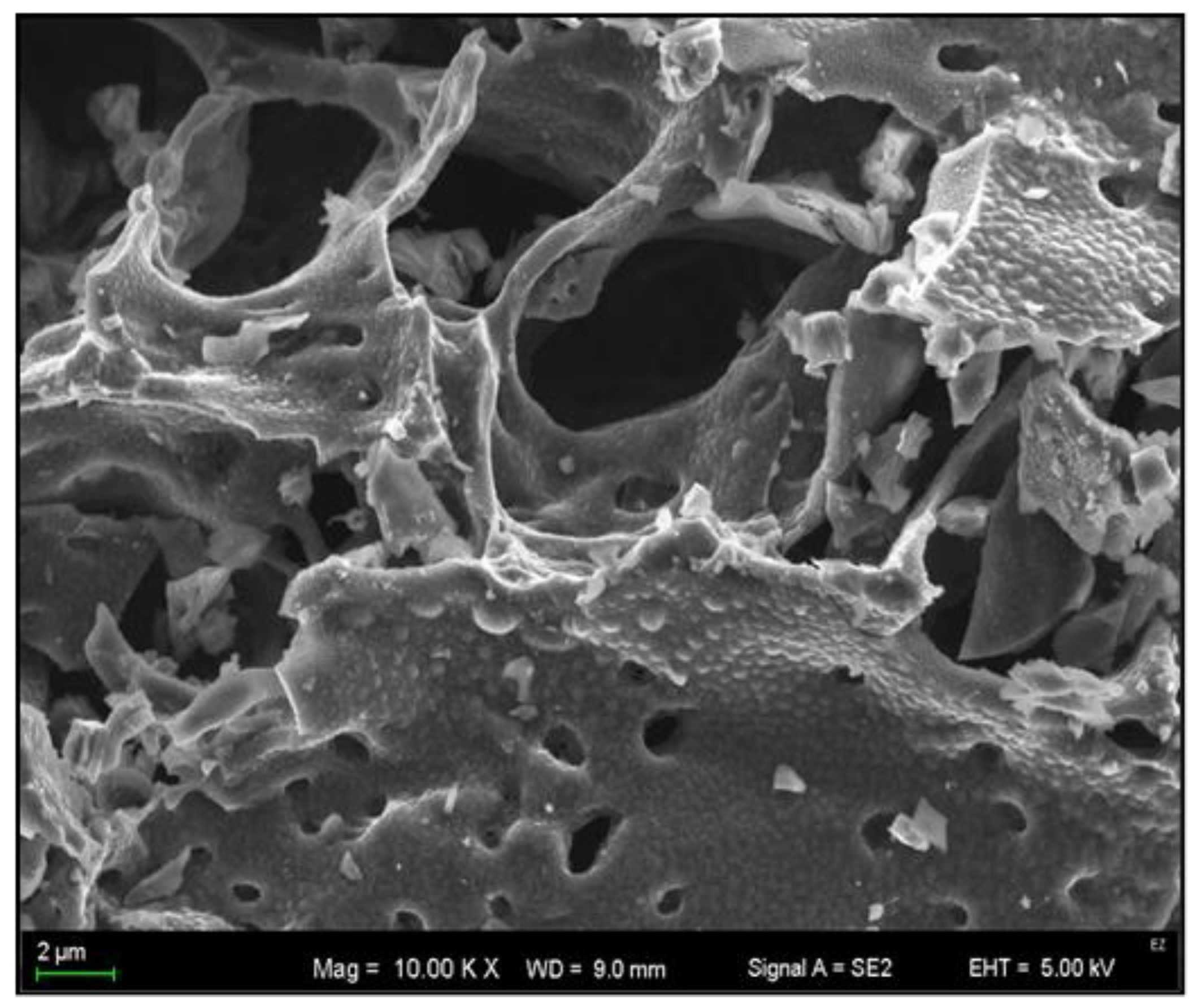
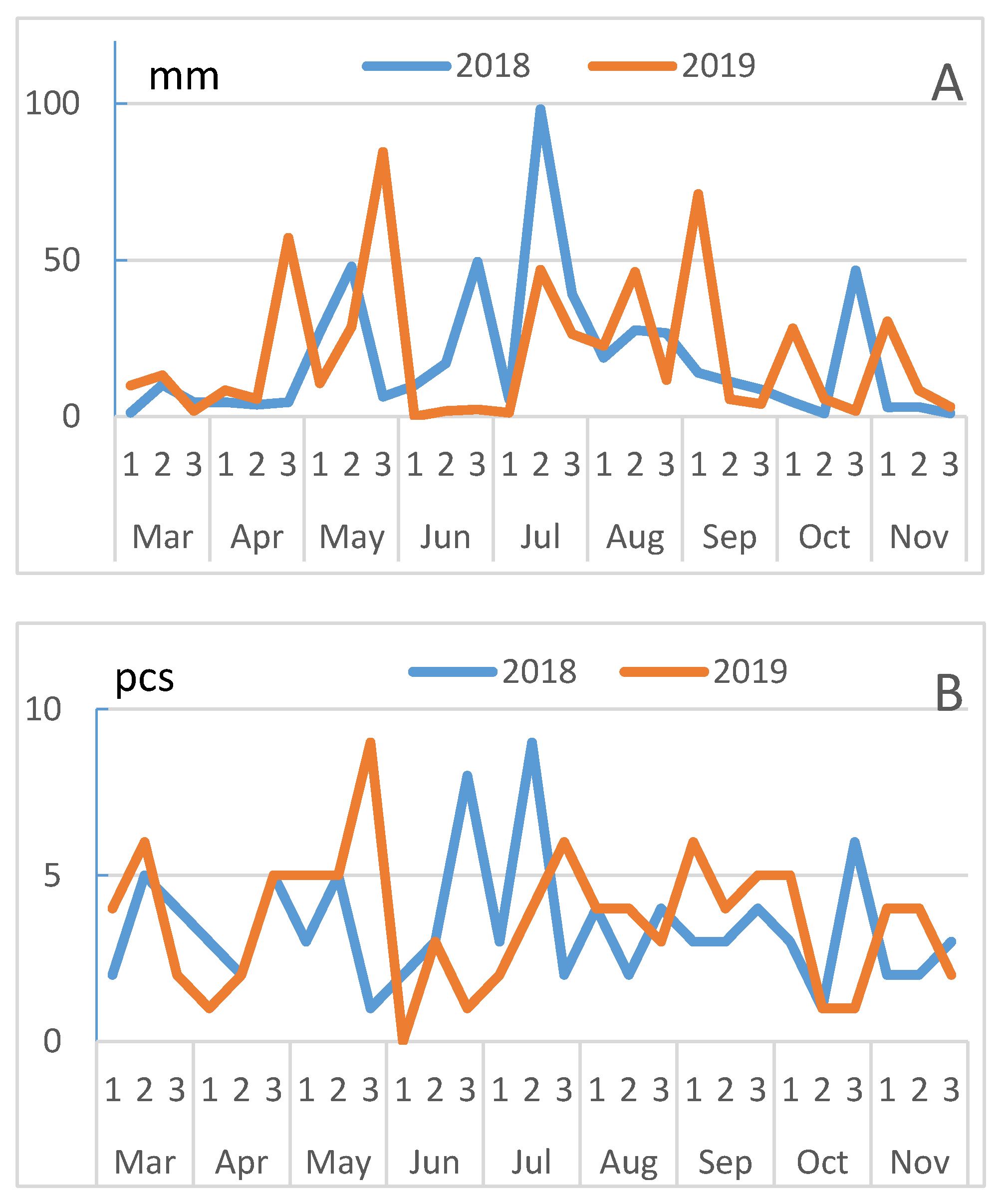


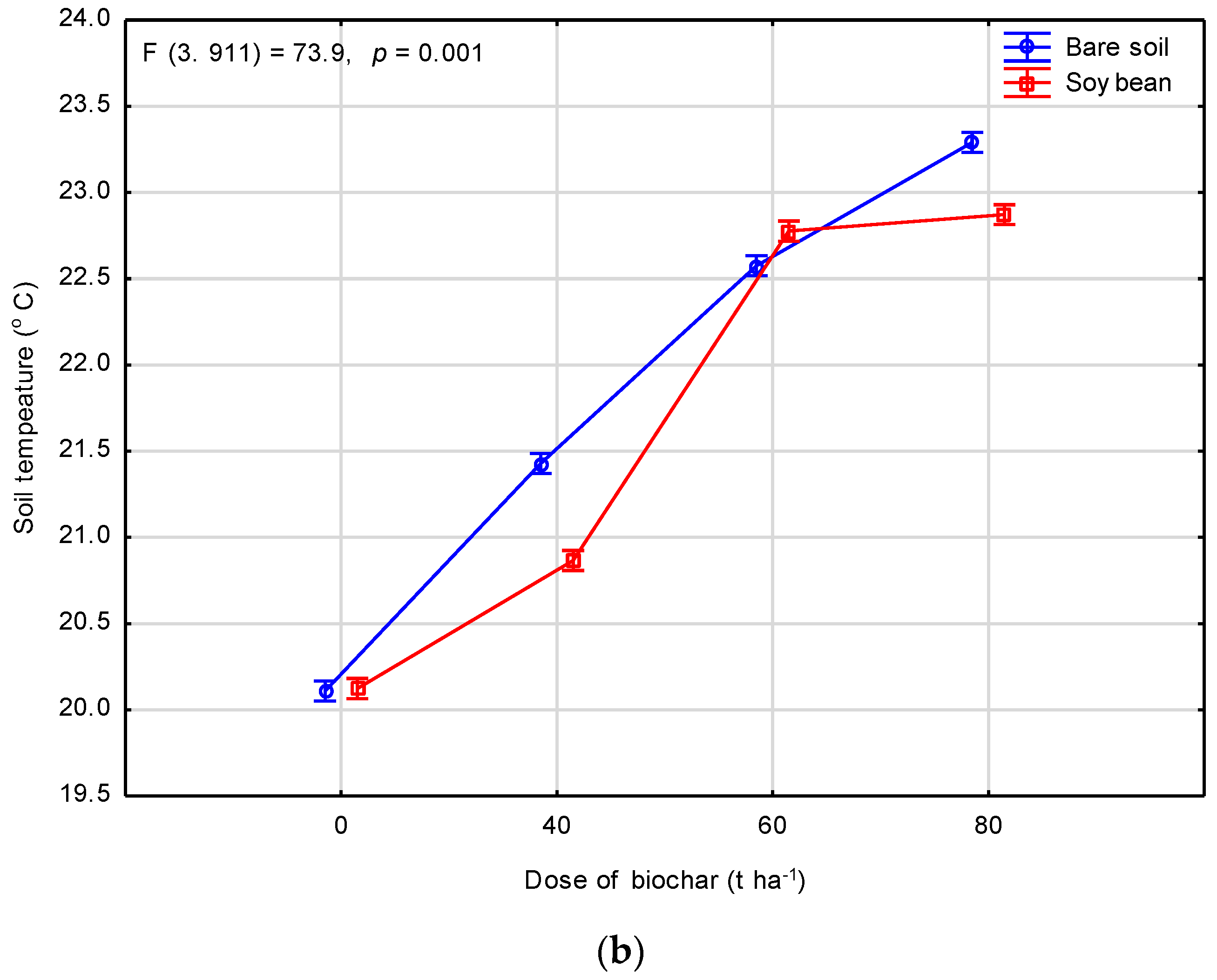
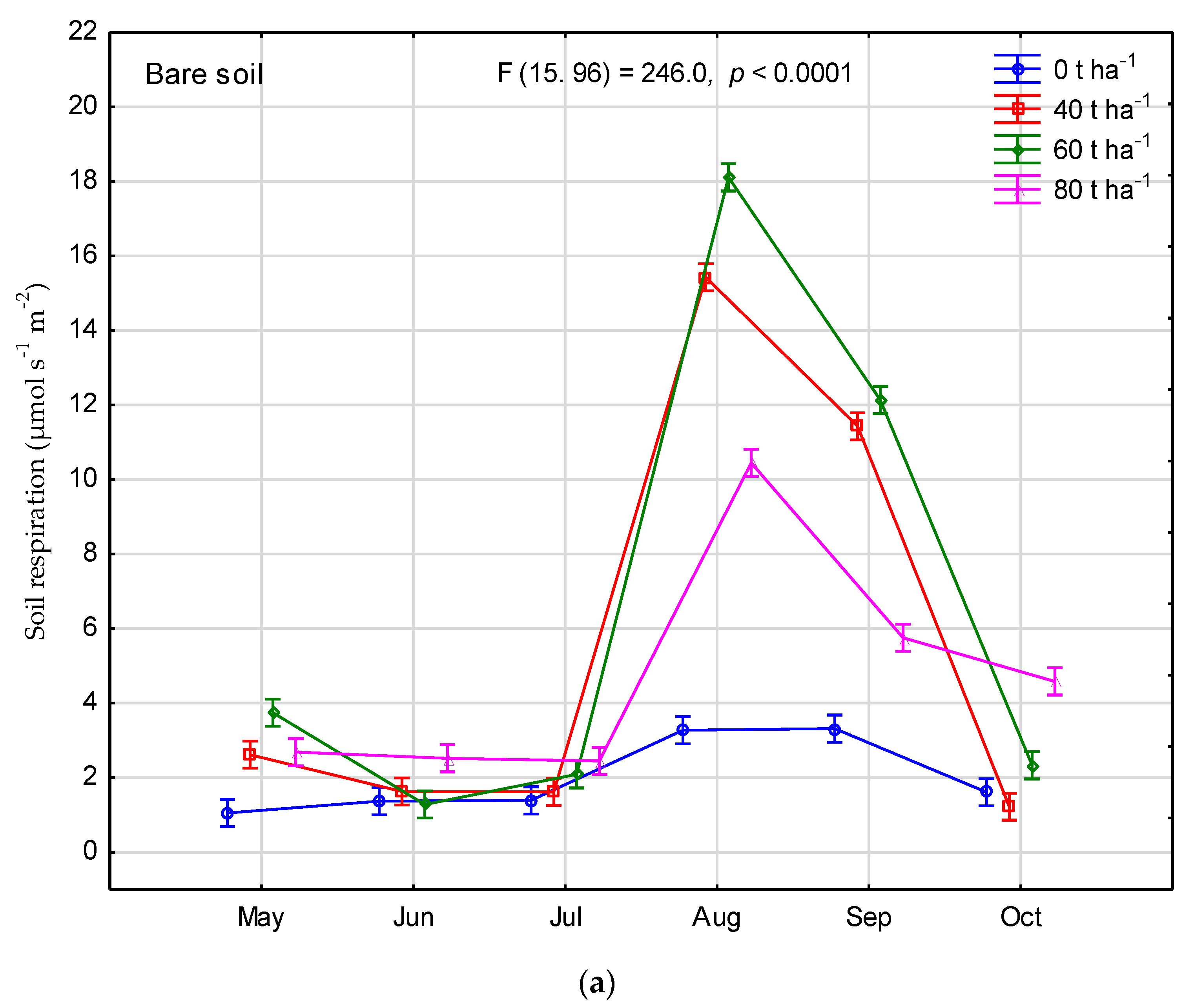
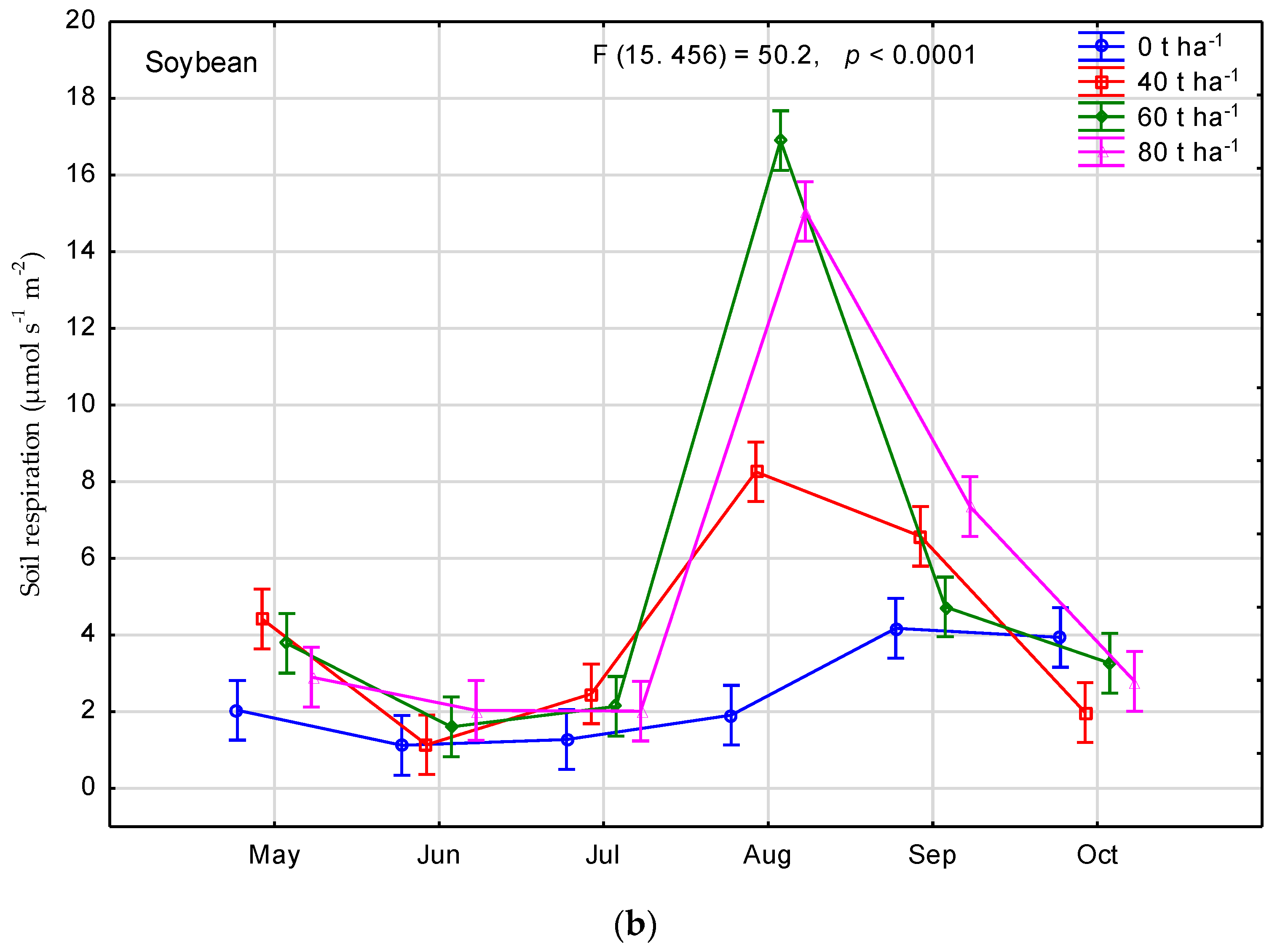
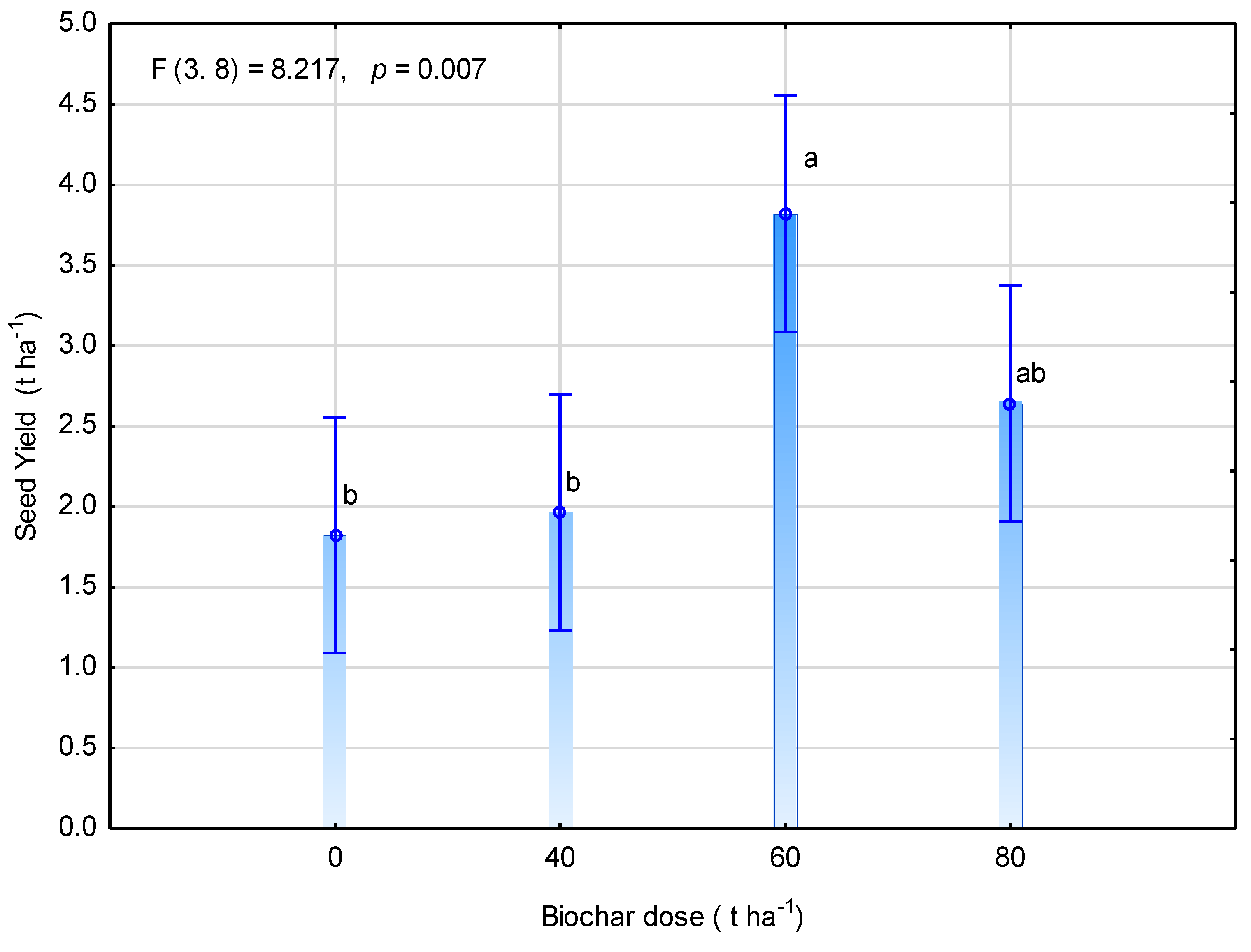
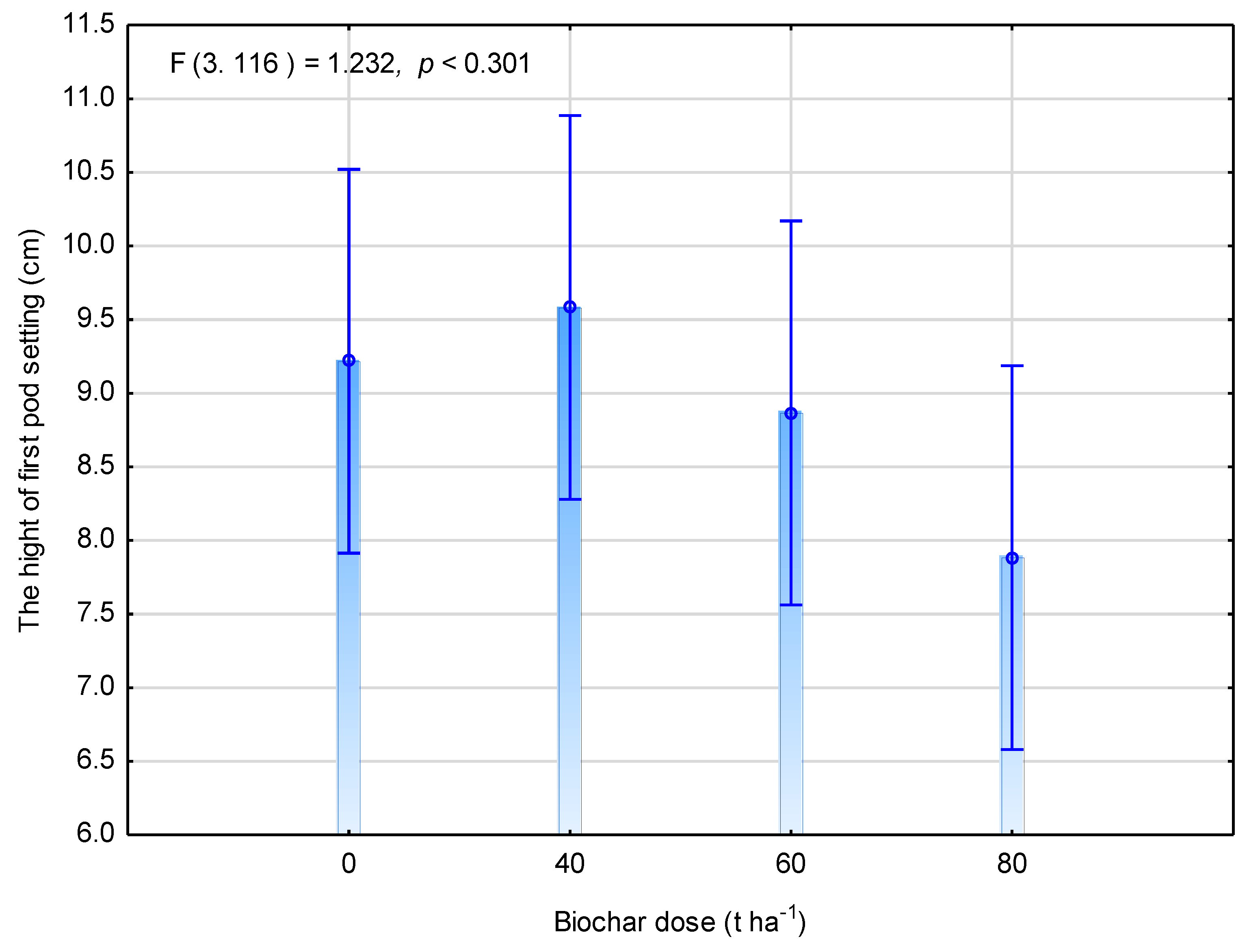
| 2018 | 2019 | Mean | |||||||
|---|---|---|---|---|---|---|---|---|---|
| SWF | SR | ST | SWF | SR | ST | SWF | SR | ST | |
| SWF | 1 | 0.76 * | 0.14 | 1 | 0.82 * | 0.71 * | 1 | 0.76 * | 0.40 |
| SR | 0.76 * | 1 | 0.42 * | 0.82 * | 1 | 0.73 * | 0.76 * | 1 | 0.55 |
| ST | 0.14 | 0.42 * | 1 | 0.71 * | 0.73 * | 1 | 0.40 * | 0.55 * | 1 |
| Dose of Biochar (t ha−1) | pH KCl | Total Organic Carbon (TOC) % | ||
|---|---|---|---|---|
| Bare Soil | Soybean | Bare Soil | Soybean | |
| 0 | 6.3 | 6.3 | 0.9 | 0.9 |
| 40 | 7.4 | 8.0 | 1.3 | 1.3 |
| 60 | 7.5 | 8.3 | 1.4 | 1.3 |
| 80 | 7.6 | 8.1 | 2.0 | 1.3 |
| p-value | ns | ns | ns | ns |
| Factor | Soil Respiration—SR (µmol s−1 m−2) | Soil Surface Temperature—ST (°C) | H2O Exchange Rate (Soil Water Flux) = SWF (m mol s−1 m−2) |
|---|---|---|---|
| Year (Y) | |||
| 2018 | 2.94 b | 22.2 a | 0.36 b |
| 2019 | 4.38 a | 21.2 b | 0.38 a |
| p-value | 0.002 | 0.04 | ns |
| Biochar dose t ha−1 (B) | |||
| 0 | 1.55 b | 20.3 b | 0.31 b |
| 40 | 4.25 a | 21.4 ab | 0.38 a |
| 60 | 4.99 a | 22.3 a | 0.39 a |
| 80 | 3.87 a | 22.7 a | 0.40 a |
| p-value | <0.001 | <0.002 | <0.001 |
| p-value Y × B | ns | ns | ns |
| Factor | Soil Respiration—SR (µmol s−1 m−2) | Soil Surface Temperature—ST (°C) | H2O Exchange Rate (Soil Water Flux) = SWF (m mol s−1 m−2) |
|---|---|---|---|
| Soil protection variant (SV) | |||
| Bare soil | 4.43 a | 21.8 a | 0.39 a |
| Soybean | 4.32 a | 21.6 b | 0.59 a |
| p-value | ns | <0.05 | ns |
| Biochar dose t ha−1 (B) | |||
| 0 | 2.21 c | 20.1 c | 0.32 |
| 40 | 4.74 b | 21.1 b | 0.37 |
| 60 | 5.56 a | 22.7 a | 0.84 |
| 80 | 4.98 b | 23.1 a | 0.43 |
| p-value | <0.001 | <0.001 | ns |
| p-value SV × B | <0.001 | <0.001 | ns |
Publisher’s Note: MDPI stays neutral with regard to jurisdictional claims in published maps and institutional affiliations. |
© 2021 by the authors. Licensee MDPI, Basel, Switzerland. This article is an open access article distributed under the terms and conditions of the Creative Commons Attribution (CC BY) license (https://creativecommons.org/licenses/by/4.0/).
Share and Cite
Klimek-Kopyra, A.; Sadowska, U.; Kuboń, M.; Gliniak, M.; Sikora, J. Sunflower Husk Biochar as a Key Agrotechnical Factor Enhancing Sustainable Soybean Production. Agriculture 2021, 11, 305. https://doi.org/10.3390/agriculture11040305
Klimek-Kopyra A, Sadowska U, Kuboń M, Gliniak M, Sikora J. Sunflower Husk Biochar as a Key Agrotechnical Factor Enhancing Sustainable Soybean Production. Agriculture. 2021; 11(4):305. https://doi.org/10.3390/agriculture11040305
Chicago/Turabian StyleKlimek-Kopyra, Agnieszka, Urszula Sadowska, Maciej Kuboń, Maciej Gliniak, and Jakub Sikora. 2021. "Sunflower Husk Biochar as a Key Agrotechnical Factor Enhancing Sustainable Soybean Production" Agriculture 11, no. 4: 305. https://doi.org/10.3390/agriculture11040305
APA StyleKlimek-Kopyra, A., Sadowska, U., Kuboń, M., Gliniak, M., & Sikora, J. (2021). Sunflower Husk Biochar as a Key Agrotechnical Factor Enhancing Sustainable Soybean Production. Agriculture, 11(4), 305. https://doi.org/10.3390/agriculture11040305










